Media: A critical tool for building advocacy networks in East Africa

Since its foundation, the East African NCD Alliance (EANCDA) has strived for an East African region that is free from NCDs. This has been done through combined efforts to put NCDs at the center of all East African health and development policies through targeted awareness, advocacy, programmatic work and outreach.
Sub-Saharan Africa has seen a rapid increase in NCDs over the last decades. Between 1990 and 2017, the proportion of all disability adjusted life-years attributable to NCDs rose from 19% to 30% of the total disease burden. NCDs are now set to overtake communicable, maternal, neonatal and nutritional conditions and diseases as cause of mortality by 2030.
In the East African Community, comprising the countries Burundi, Rwanda, Kenya, Tanzania, South Sudan and Uganda with a population of 177 million, 40% of all deaths are attributable to NCDs. The rising burden of NCDs is linked to several risk factors including globalization of trade, rapid unplanned urbanization, changes in nutrition, demography and environmental factors including climate change and air pollution, which are becoming increasingly prevalent.
In addition, the COVID-19 pandemic has created a wider gap in access to effective information, especially for people living with NCDs. This is why we implemented a project to enhance the use of media as a tool for advocacy and awareness on NCD prevention and control in East Africa, which has been supported via the first and second phases of NCDA’s Civil Society Solidarity Fund.
Engaging with the media for NCD advocacy and awareness
Media thrives on attention-grabbing by using personal stories to position key messages. Media outlets and journalists have mastered the art of developing emotionally compelling stories by drawing from communities, in search of a more human perspective. Journalists have the power to change perceptions to contribute to social change by setting the agenda and focusing public interest on a particular issue. There is huge potential for turning to media as an opportunity to whip up public consciousness on NCDs.
The content of the trainings was decided through tracking the people living with NCDs, advocates and experts who were key participants. And we solicited the best professional facilitators to support the trainings. The EANCDA members were the direct implementers of the trainings, responsible for tracking progress and ensuring that the intended goals were achieved. Their support was also critical during the development of the media contact list that informed the media workshops and engagements.
Building capacity of media to report and champion the NCDs agenda
Although media has the potential to achieve a valuable impact on awareness, journalists don’t necessarily have the technical capacity to process medical information. They are continuously struggling to find content to publish on NCDs and health generally that could be appealing to the public.
To bridge this gap, EANCDA came up with a systematic, sustained mutual capacity development, organized to train journalists to tell the stories of people living with NCDs, and develop interesting media content by turning NCDs advocacy discourses into compelling personal living experiences. The trainings also focused on building mutual relationships between journalists, advocates, and experts. People living with NCDs and advocates were also trained on how to articulate in a simpler way for public communication.
The content was created through a broad needs assessment process. An inception stakeholder’s meeting was held, where concerns were raised on NCDs and a discussion on what should be prioritized during the trainings was conducted. Secondly each member of East NCD Alliance filled in a tool that was sent for them to input based on the priority areas and concerns. For every engagement with the media, meetings to develop a themed content that needed a focus within that period was conducted.
An independent “Review and Selection Committee” was initiated to recommend journalists for both the network and the recipients of the East Africa Media on NCDs Awards (EAMNA Awards). Every journalist that received an award was viable for being part of the network. Through that process, 30 journalists were recruited, and we have included five more journalists along the way.
What has been achieved so far?
The trainings have strengthened the capacity of 150 journalists within the East African Region on NCDs and infectious diseases, including on the intersections between NCDs and COVID-19. In addition, an East African Journalist Network on NCDs was developed with a database of 35 journalists. The network is important for easy access to media services on NCDs, and will also participate in research, innovations, and raising voices of people living with NCDs in the region. The media network will finally support the region to advocate for NCDs prevention and control by pushing governments to act.
Although we have faced some challenges, such as the competitive media environment, the implementation of this project has made it possible to achieve over 50 news articles, 27 guest appearances, five op-ed newspaper commentaries, five NCD themed TV and radio programmes, and seven special features on people living with NCDs. Media should be part of any NCD advocacy agenda working towards building back better and fairer.
About the East African NCD Alliance
East African NCD Alliance was formed in 2014 with an overall objective to influence EAC and national governments in East Africa, to increase political priority and resources for NCDs, and promote the importance of NCDs in the post-2015 development agenda. The initiative aims at strengthening the capacity of the NCD Alliance in East Africa and fostering collaboration between them.
Organization website: https://eancda.org/
Twitter @eancdalliance